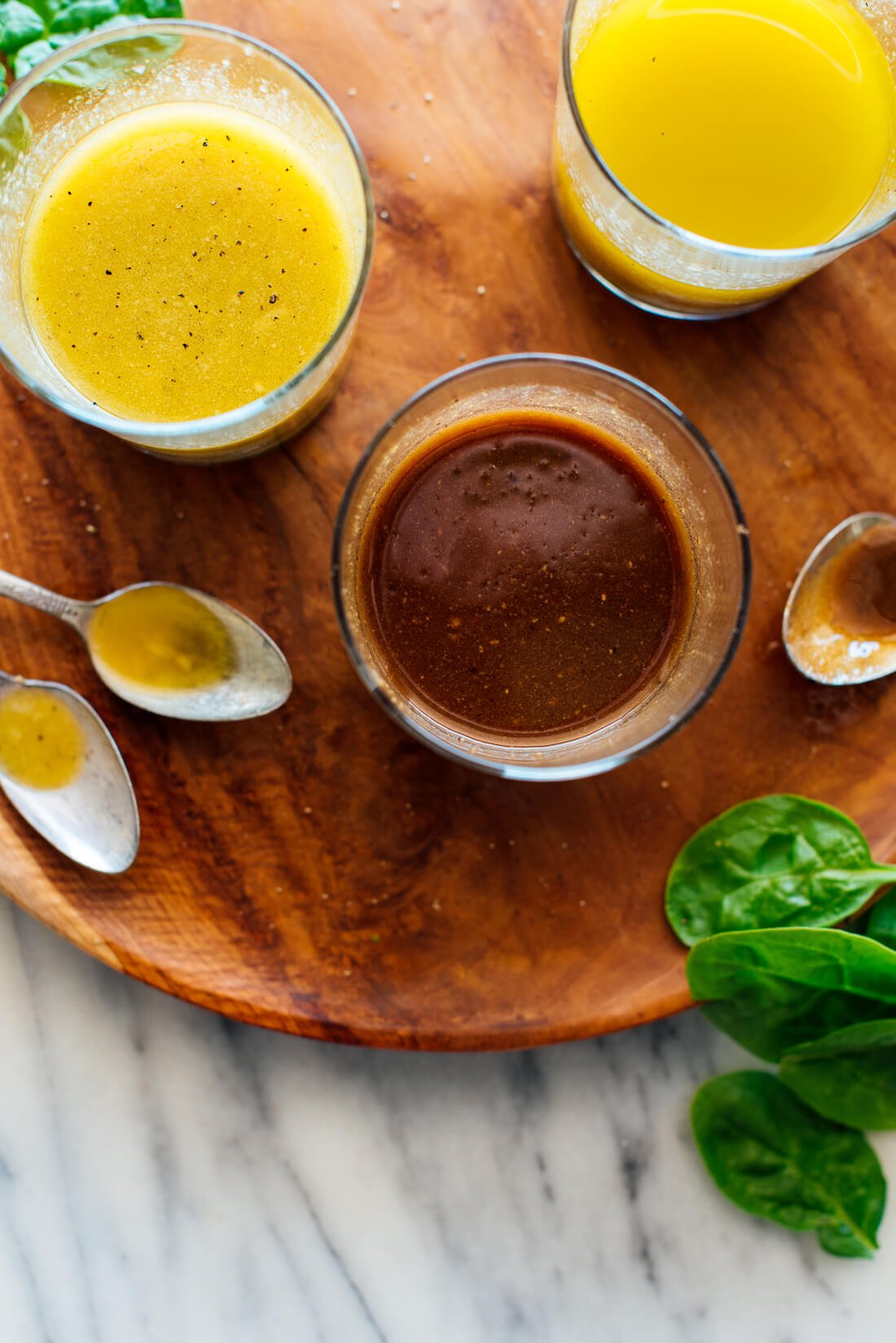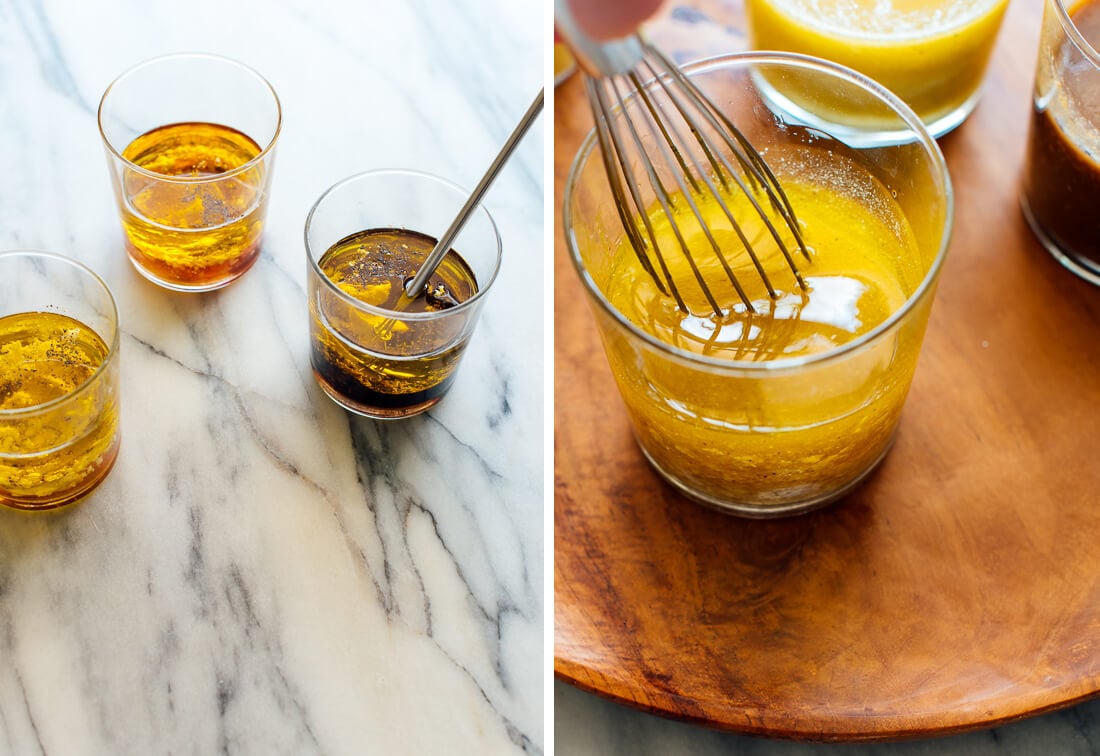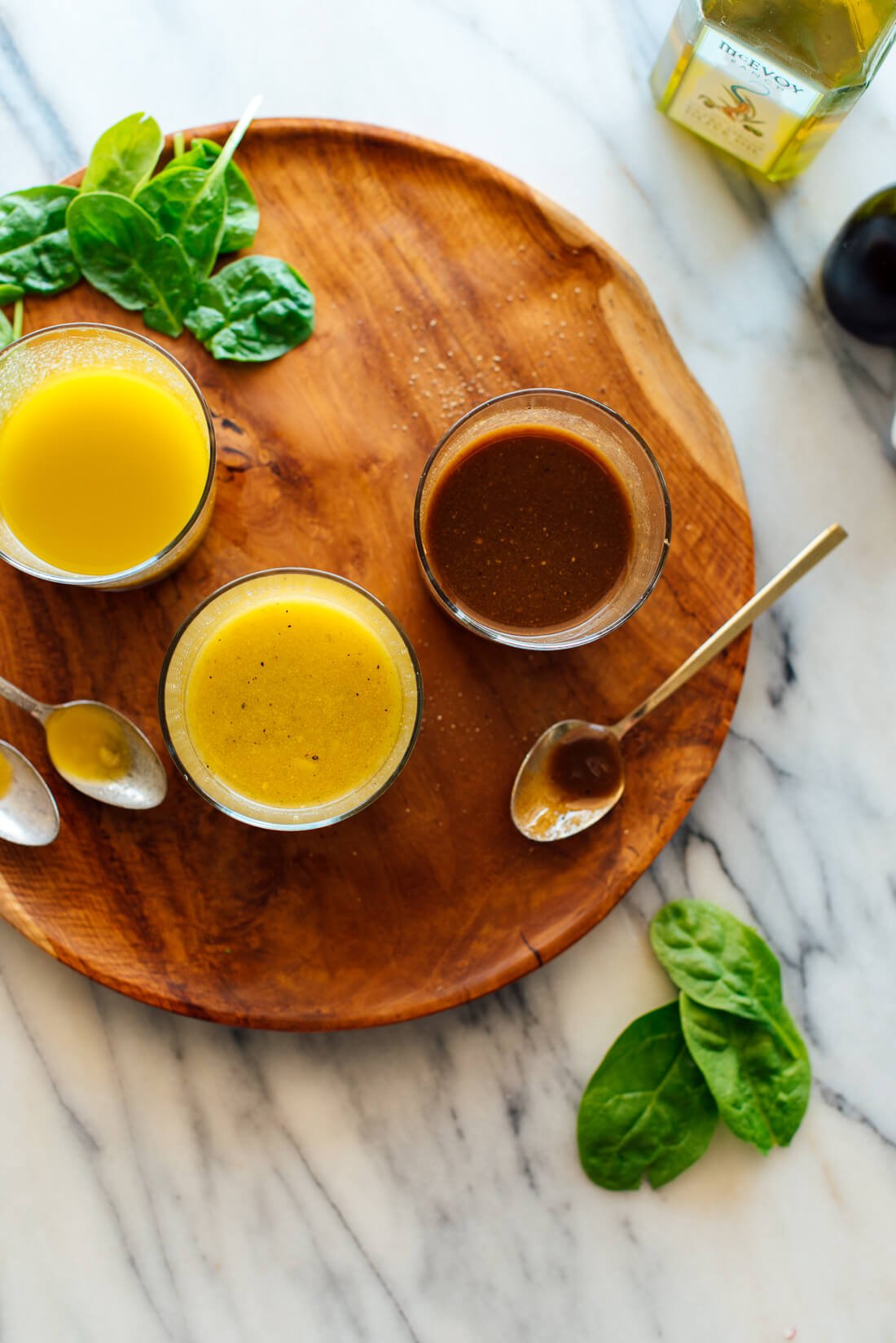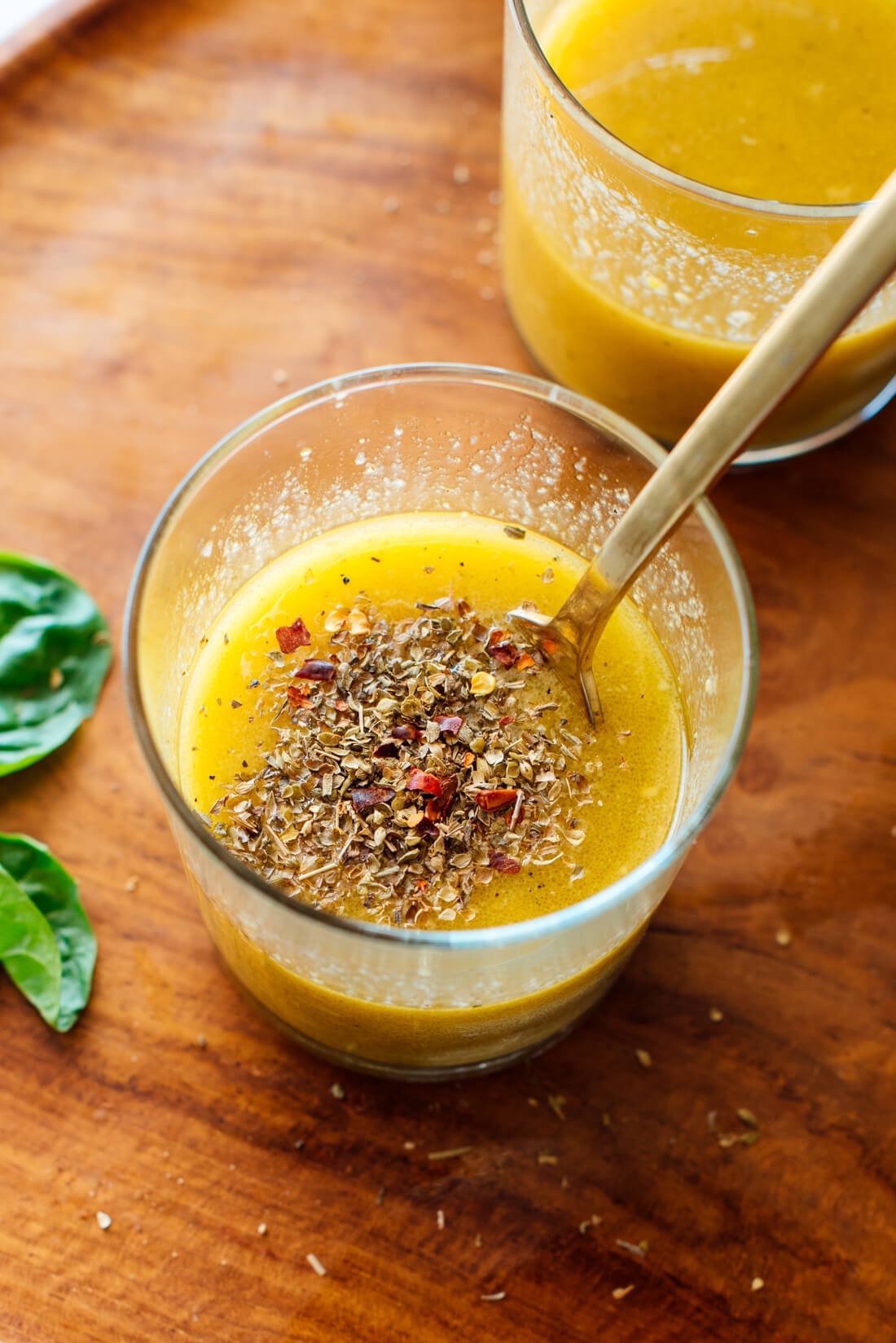How to Make Vinaigrette (Plus 3 Essential Variations!)
Here's my go-to vinaigrette recipe! So easy and tastes way better than store-bought dressing. This versatile recipe will take your salad to the next level.
Updated by Kathryne Taylor on August 28, 2024

We’re going back to basics today with one of my most essential everyday recipes, vinaigrette! You know how much I love salads, and I’m surprised I didn’t think to share my basic vinaigrette recipe with you until now.
Vinegar and olive oil-based vinaigrette is a light, zippy, heart-healthy salad dressing. It’s great on greens, vegetables and fruits. You can change up the flavor by using different vinegars. Vinaigrette is easy to adjust to taste, and I’ve included notes how to do so in the recipe.
Once you start making homemade vinaigrette, you won’t go back. Whisk together some basic ingredients, and you’ll end up with dressing that tastes infinitely better than store-bought dressings. No preservatives here!
Homemade vinaigrette keeps for 1 to 2 weeks in the refrigerator, so it’s worth the 5 minutes it takes to mix it up. Then you can keep it on hand for all of your salad needs. Let’s get to it!

Basic Vinaigrette Ratio & Ingredients
The traditional French vinaigrette formula calls for 1 tablespoon vinegar for every 3 tablespoons olive oil. Modern vinaigrettes often call for a bit more vinegar than that, but it’s always up to you. Kale salads can tolerate more zingy dressings, while you’ll want to use less vinegar for mild greens like spring greens.
Here’s what you’ll need to make vinaigrette:
- Olive oil for your base
- Vinegar of choice
- Dijon mustard for some flavor complexity and creaminess
- Maple syrup or honey for a little sweetness that balances the vinegar
- Garlic for oomph
- Salt and pepper

Vinaigrette Varieties
While you can use any tasty vinegar you’d like to make vinaigrette, here’s how I choose between my three go-to vinegars.
Balsamic Vinaigrette
Balsamic vinegar makes a bold, slightly sweet dressing that is wonderful on green salads with fruit, such as apples, strawberries or peaches. Examples include my strawberry arugula salad and favorite green salad with apples.
Red Wine Vinaigrette
Red wine vinegar packs a punch and works well with other bold flavors and bright veggies, like tomatoes, bell peppers, olives, feta and more (think Greek salads or Italian salads).
White Wine Vinaigrette
White wine vinegar a more mellow vinegar and it’s especially nice with more delicate flavors like spring greens, cucumber, zucchini and sweet corn. It’s lovely on just about every green salad out there. I’ve used it recently in my orange orzo salad and corn salsa.
Additional Options
Champagne vinegar is even more mild than white wine vinegar. Apple cider vinegar is sweet-tangy and tastes lightly of apples. Sherry vinegar is similar to red wine vinegar but slightly less intense.
Watch How to Make Vinaigrette

Please let me know how you like this vinaigrette in the comments! I love hearing from you and I’m dying to hear about the salads you make with it (#saladobsessed).
If you’re looking for more salad dressings that keep well, don’t miss my sunshine salad dressing (yogurt-based honey-mustard dressing), green goddess dressing, carrot ginger dressing or jalapeño-cilantro dressing (made a little creamy with some tahini).
You’ll also find four delicious salad dressings in my book, Love Real Food. Many more salads here!

Basic Vinaigrette (Plus Variations!)
Here’s my go-to vinaigrette recipe! It’s so easy to make and tastes way better than store-bought dressings. You can change up the flavors by choosing the vinegar that suits your salad best. Recipe yields ¾ cup dressing, enough for about 6 medium salads (assuming 2 tablespoons per salad).
Ingredients
- ½ cup extra-virgin olive oil
- 3 tablespoons vinegar of choice (balsamic vinegar, red wine vinegar, white wine vinegar)
- 1 tablespoon Dijon mustard
- 1 tablespoon maple syrup or honey
- 2 medium cloves garlic, pressed or minced
- ¼ teaspoon fine sea salt, to taste
- Freshly ground black pepper, to taste
Instructions
- In a liquid measuring cup or bowl, combine all of the ingredients. Stir well with a small whisk or a fork until the ingredients are completely mixed together.
- Taste, and adjust as necessary. If the mixture is too acidic, thin it out with a bit more olive oil or balance the flavors with a little more maple syrup or honey. If the mixture is a little blah, add another pinch or two of salt. If it doesn’t have enough zing, add vinegar by the teaspoon.
- Serve immediately, or cover and refrigerate for future use. Homemade vinaigrette keeps well for 7 to 10 days. If your vinaigrette solidifies somewhat in the fridge, don’t worry about it—real olive oil tends to do that. Simply let it rest at room temperature for 5 to 10 minutes or microwave very briefly (about 20 seconds) to liquify the olive oil again. Whisk to blend and serve.
Notes
Balsamic vinegar: Makes a bold, slightly sweet dressing that is wonderful on green salads with fruit, such as apples, strawberries or peaches.
Red wine vinegar: Packs a punch and works well with other bold flavors and bright veggies, like tomatoes, bell peppers, cucumber, cabbage and more (think Greek salads).
White wine vinegar: This is a more mellow vinegar and it’s especially nice with more delicate flavors like cucumber and sweet corn. It’s lovely on just about every green salad out there.
Greek/Italian variation: Use red wine vinegar. Add 1 to 2 teaspoons dried oregano and, optionally, a pinch of red pepper flakes.
Nutrition
The information shown is an estimate provided by an online nutrition calculator. It should not be considered a substitute for a professional nutritionist’s advice. See our full nutrition disclosure here.
















This was a great new vinaigrette dressing for me!
Your balsamic vinaigrette was absolutely amazing. I understand why you said never use store-bought again. I am on your bandwagon!!!
Yum! Thanks for the variations and the explanation of what type of salad to pare them with.
I am going to be making this soon, and wondered about substituting avocado oil or coconut oil. Would these work as well, or due to chemical natures would adjustments need to be made? Or is it not recommended at all to use anything other than olive oil? Thanks in advance.
Hi Kat, olive oil is going to give the best flavor in a vinaigrette. Avocado oil would work, as it is a neutral flavor, but it is generally best for cooking as it has a high smoke point. I would not recommend coconut, as it would impart a strong flavor.
I won’t use bottled Italian dressing ever again! This recipe is delicious, and with the variations suggested, keeps me from getting bored with the taste. My friends ask if I made my own dressing at parties; they prefer this dressing to any other I have on the table.
I just made this recipe with red wine vinegar. It was very easy to prepare, but for some reason, mine developed a bitter aftertaste. Do you know what might have caused that, or what I can do to counteract it? Thank you so much for any suggestions! :)
Hi Kimberly, did you include the bit of sweetener? Did you remove the green centers from your garlic? The shoots can give a bitter taste.
Super simple to make and very tasty! I used balsamic vinegar and also added a tablespoon of real lemon juice. Thx for the recipe!!
Although I am rating your balsamic version of the vinaigrette, which is delicious, it is worth noting that I have tried other recipes you have provided us, and all have been extremely good. Not a dud in the bunch. This is one that I will keep in my rotation. There are probably 10 of your recipes in my recipe folder and I plan to start working my way through the ones I haven’t made yet. Thank you.
Thanks for the recipe! I made a white wine vinaigrette, substituting miso for the honey. Spectacular! Nice work.
Can’t wait to make it
I am so excited to find your website. I have been looking for natural ways to prepare meals. Thanks for all your diligence!!
Delicious! Thank you! I made the white wine kind and put it on a berry, apple salad!